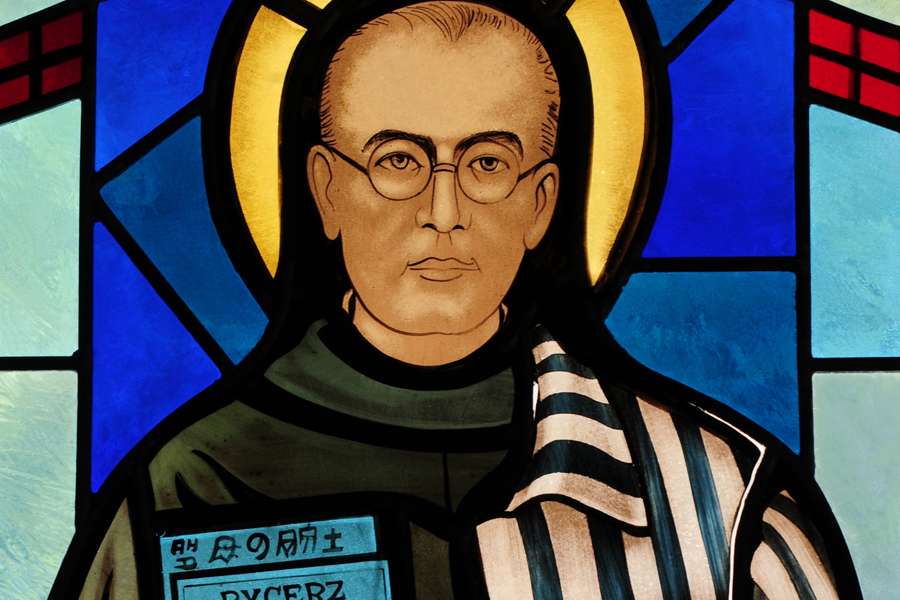The Miraculous Medal – St Maximilian Kolbe’s weapon for evangelisation

1909 WORLD Maximilian Kolbe Credit Nancy Bauer via wwwshutterstockcom CNA
ROME, ITALY: As World War II raged around him in Poland, St. Maximilian Kolbe fought for souls using a printing press and another “weapon” – the Miraculous Medal.
“Even though a person be the worst sort, if only he agrees to wear the medal, give it to him…and then pray for him, and at the proper moment strive to bring him closer to his Immaculate Mother, so that he have recourse to her in all difficulties and temptations,” Kolbe said of the Miraculous Medal.
“This is truly our heavenly weapon,” the saint said, describing the medal as “a bullet with which a faithful soldier hits the enemy, i.e. evil, and thus rescues souls.”
The Miraculous Medal is a sacramental inspired by the Marian apparition to St. Catherine Laboure in Paris in 1830. The Virgin Mary appeared to Laboure as the Immaculate Conception standing on a globe with light streaming from her hands and crushing a serpent under her foot.
“A voice said to me, ‘Have a medal struck after this model. All who wear it will receive great graces, especially if they wear it around the neck,” Laboure said.
As a Franciscan seminarian studying in Rome in 1917, Kolbe was moved by the story of the role the Miraculous Medal played in the conversion of Alphonse Ratisbonne.
Ratisbonne was a French Freemason and an atheist of Jewish descent, who received the grace of conversion while wearing a Miraculous Medal given to him by one of his Catholic friends in Rome. The Virgin Mary appeared to Ratisbonne Jan. 20, 1842 in a side chapel in the Church of Sant’Andrea delle Fratte in Rome.
St. Maximilian Kolbe chose to celebrate his first Mass April 29, 1918 in the side chapel in Sant’Andrea delle Fratte, where the Virgin Mary appeared to Ratisbonne.
Ratisbonne went on to be ordained a Jesuit priest, and eventually left the order to move to Jerusalem in 1855 to found a convent for sisters in the Congregation of Our Lady of Sion, a congregation founded to “to witness in the Church and in the world that God continues to be faithful in his love for the Jewish people.”
Kolbe went on to give his life for a Jewish man imprisoned with him in Auschwitz, who had a wife and children. He died of a carbolic acid injection in the concentration camp Aug. 14, 1941. The Nazi officials cremated Kolbe’s body on the feast of the Assumption of Mary.
Kolbe is known for being an effective evangelist and missionary. Before moving to Japan in 1930, Kolbe made a pilgrimage to the Chapel of the Miraculous Medal on Rue de Bac in Paris.
St. Pope John Paul II remembered Kolbe’s visit when he prayed in the Paris chapel in 1980:
“I come as a pilgrim, after all those who came to this chapel in 150 years, like all Christians who flock here every day to express their joy, their trust and their supplications. I come as Blessed Maximilian Kolbe: before his missionary journey to Japan, just fifty years ago, he came here to seek your support to propagate what he later called ‘the Militia of the Immaculate’ and undertake his prodigious work of spiritual renewal under your patronage, before giving his life for his brothers,” John Paul II said.
Kolbe formed the Militia Immaculata in 1917 to “lead every individual with Mary to the most Sacred Heart of Jesus.” He asked all Militia Immaculata members to wear the Miraculous Medal as a sign of their total consecration to Mary.
“Now in this epoch of the Immaculate Conception the most Blessed Virgin has given mankind the ‘Miraculous Medal’. Its heavenly origin has been proven by countless miracles of healing and particularly of conversion,” Kolbe wrote.
“The Immaculata herself in revealing it promised all who would wear it very many graces; and since conversion and sanctification are divine graces from God, the Miraculous Medal will be one of the best means for attaining these gifts,” he said.
Kolbe also added to St. Catherine’s prayer associated with the sacramental: “O Mary, conceived without sin, pray for us who have recourse to you.” To this, Kolbe added, “and for all who do not have recourse to you, especially the enemies of the Church and those recommended to you. Amen.”



My breviary has a story by inmates of Auschwitz that said he was sent to the starvation chamber (when he took the place of the other prisoner) – and died from starvation, not lethal injection
What a wonderful article on a great saint!
Lindsay Roe – your breviary is correct in saying that the saint was sent with others to the starvation chamber. But after so many days, St Maximilian did not die, and the prison guards needed the chamber to starve other prisoners, so they injected the saint with a lethal dose of carbolic acid. See: https://www.ewtn.com/catholicism/saints/maximilian-mary-kolbe-699.
The Miraculous Medal is a must have! If any groups, parish or schools in our Archdiocese would like some, please contact the Legion of Mary Canberra-Goulburn (the distribution of the Medal has always played a special part in the Legion apostolate). We can provide a Medal + leaflet (explaining how Our Lady appeared to St Catherine Laboure) for a very nominal amount (25cents). Bulk orders welcome. Email: LegionOfMaryCanberra@gmail.com.